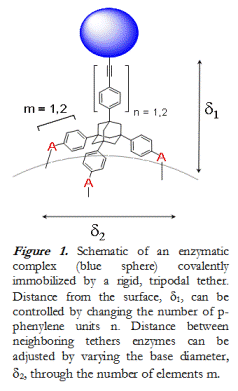322d Preparation of Tuneable Biofunctionalized Surfaces for Sensing and Biomedical Applications
Methods for the controlled organic surface functionalization of inorganic materials are critical for the synthesis of many new classes of hybrid materials. Numerous examples exist in the semiconductor industry and in biomaterials research, where the objective is to combine the mechanical, structural, and electrical properties of the bulk materials with tailored surface characteristics, such as tuneable reactivity, biocompatibility, or hydrophobicity. Additionally, there are many emerging applications, such as nanoparticle functionalization and chiral organometallic complex immobilization, to produce new and efficient catalysts for pharmaceutical syntheses. We recently presented a powerful method, combining the use of well-defined surfaces with infrared spectroscopy, to elucidate the mechanisms of surface chemical functionalization, including hydrosilylation reactions to immobilize an indene ligand to a Si(111) surface.[1]. Now, we are going to present the latest results of our research towards the immobilization of tripodal tethers on silicon surfaces and the subsequent coupling of catalytically active moieties to these tethers. Using these tethers, the distance and the direction of the catalytic moiety from the surface can be controlled (Figure 1). Furthermore, the rigid rod spacer arms prevent backfolding of the catalyst onto the surface. In addition it has been shown, that these conjugated molecules are able to transport electrons rapidly from the surface to the top end group [2], making our approach useful for applications in the field of nano-bio technology. Using photo-patterning techniques, different patterned surfaces can be obtained. This is a promising approach towards the development of heterogeneous multistep catalysts and complex sensing devices, especially when a semiconductor surface is used as solid support for the sensing molecules (e.g., redox enzymes). In the talk we will present the functionalization of the surface, as well as some model catalysts linked to the functional surfaces. References:
[1] Langner, A.; Panarello, A.; Rivillon, S.; Vassylyev, O.; Khinast, J. G.; Chabal, Y. J., J. Am. Chem. Soc., 2005,127, 12798-12799.
[2] Galoppini, E., Guo, W., Zhang, W., Hoertz, P.G., Qu, P., and Meyer, G.J., J. Am. Chem. Soc., 2002, 124, 7801 - 7811
